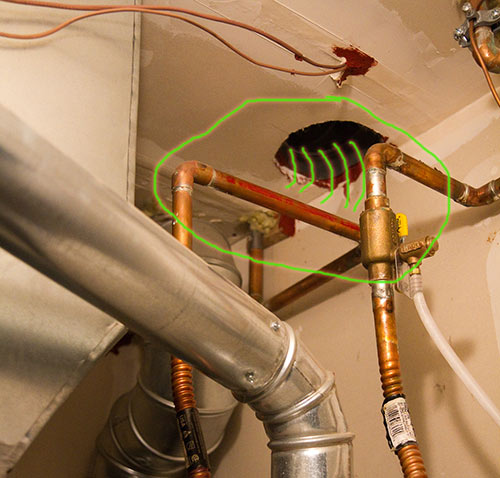Homeownership is the art of plumbing
I woke up this morning to find the sun shining and the world glistening white. As always, I let Sophie outside and back in, then I returned upstairs for a warm shower. I twisted the knob to hot on the shower. Instead of a glorious steamy spray of heat, my action was met only with a dribble of cold. There was no water pressure. I put on a robe and began to investigate.
Despite being only November, the temperature had dipped to -10 °F overnight. My immediate suspicion was that a pipe had frozen somewhere or a water main had burst. The problem with the idea about a pipe freezing was that none of my plumbing ran in exposed locations. While my water heater did reside in a closet attached to my garage, the door opened into the garage, and being a townhouse, the garage stayed relatively warm: 45 °F according to my IR thermometer. The closet, which also held my furnace, was about the same temperature.
A new possibility sprung to mind. What if the pipe leading from the main to my meter had frozen? That would have been a real pain, as it ran underneath my concrete driveway.
Perhaps the blockage was somewhere else in the house, maybe a poorly routed pipe running through an exterior wall. I started going through the various faucets in the house and turning on the hot water to no avail. Then I got to the kitchen sink, which unlike the other faucets had a single handle to mix both hot and cold. I pulled the handle, and a healthy stream of water came out. Curious, I moved the handle back and forth from cold to hot. Cold worked great. Hot worked not at all. I figured that something had clogged the hot water heater.
Back to the garage I went.
With a flashlight, I began inspecting the hot water heater and its pipework. I followed the hot-water outflow pipe up from the water heater and… right past the fresh-air intake for the furnace.

Cold air getting sucked past the water pipes
The furnace had been running a lot during the night, so it had been consuming a lot of air, so a lot of very cold outside air had been flowing into the closet. Since no hot water was flowing while I was sleeping, all of that cold air had cooled the hot water line below the freezing point. A quick check with the IR thermometer confirmed that a short section of the pipe was at 28 °F –just below freezing.
Crossing my fingers that the pipe had not been frozen severely enough or long enough to do any lasting damage, I decided to unthaw that section. First, I turned on several faucets to hot so that any water movement would draw hot water from the tank and warm the icy blockage. Next, I got out a space heater, set it to high, and pointed it at the pipe above my head. After about a minute, I started hearing the hiss of a small amount of water beginning to flow. Thirty seconds after that, there was a bang, the pipe shook, and the water flowed. No leaks.
Back at the faucets, the water was gushing forth, hot and plentiful. I smiled and took a gloriously warm shower.
Update: It turned out that there was a second vent pipe to the outside. It’s visible as the large bent pipe in the background of the image above. The vent pipe that was causing me problems appears to have no specific purpose. I’m at a loss to explain it; it doesn’t appear on any furnace-installation diagrams that I’ve found. I could see how it might be useful if I were to install a high-efficiency furnace in the future, as those vent out walls instead of out a chimney, but that’s just speculation.
Update 2: Apparently, it’s not uncommon to have a second vent to the outside. I ended up solving my problem by adding foam insulation around the pipes and adding some semi-rigid material to deflect any incoming air away from the pipes.
Recent Comments